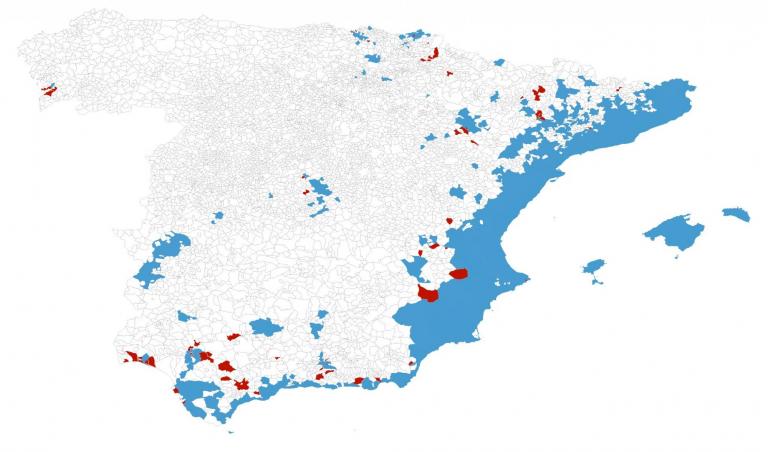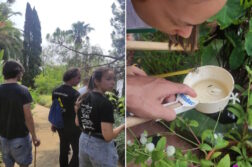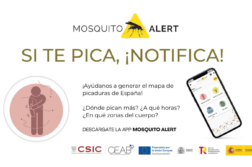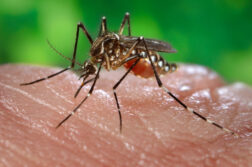The commitment of citizens allows the detection of tiger mosquitoes in seventy municipalities this 2023. Close collaboration with public health managers makes possible to confirm alerts in less than 24 hours.
This October, with the citizen science platform Mosquito Alert, the presence of tiger mosquitos (Aedes albopictus) has been detected in 10 municipalities in which there was no evidence of its existence before. And, so far this year, citizens have allowed the detection in 70 municipalities throughout the Spanish state.
Collaboration with the Ministry of Health has contributed to achieving this objective. The State has encouraged the use of Mosquito Alert with the dual purpose of raising awareness among the population and, at the same time, contributing to the study and monitoring of invasive mosquitoes. The massive response of citizens, concerned about this problem, has allowed, in just three months, to collect more than 10,000 reports with images of mosquitoes and 17,900 notifications of bites. This has led to the early detection of the tiger mosquito in 70 municipalities, highlighting its first detection in Galicia. It has also helped raise awareness about simple actions that can be taken to prevent the proliferation of mosquitoes, such as avoiding accumulations of water in both public and private spaces.
 1. Map with the 70 new municipalities in which the tiger mosquito has been detected
1. Map with the 70 new municipalities in which the tiger mosquito has been detected
On the map, in blue, the known distribution of the tiger mosquito in Spain. In red, new detections through the use of Mosquito Alert and thanks to citizen participation in 2023. As the map shows, citizen science makes it possible to detect the tiger mosquito beyond its known distribution limit.
A success reinforced by the incorporation of artificial intelligence
The speed with which the mosquito is detected in places where its presence was not known is due, among others, to the implementation of an artificial intelligence system (called AIMA). Trained with more than 7,000 images contributed by the community over the years and classified thanks to the experience of the members of the ReNED (National Network of Digital Entomology), AIMA performs a first classification, almost instantaneous, of the photos sent by the citizens . This work does not replace expert personnel, who subsequently validate the alerts. However, it allows you to go faster and concentrate your efforts on the most difficult images.
The alert system, which combines the immediacy of artificial intelligence with the supervision of human experience, has led, among other discoveries, to the first detection of the tiger mosquito in Galicia: first, in the municipality of Moaña and later in Vigo, Cangas and Redondela. The coordination between Mosquito Alert, the Xunta de Galicia and the ReGaViVEC (Galician Vector Surveillance Network) made it possible to confirm the presence of the tiger mosquito on the ground in less than a day.
Roger Eritja, head of entomology and data validation manager, remembers the process: “the user’s image was sent at 5:05 p.m. AIMA issued an alert at 6:00 p.m. and that same day we contacted the person who uploaded the image via a mobile notification, maintaining anonymity. The same afternoon, ReGaViVEC and Xunta were contacted and an action on the ground was coordinated that allowed the detection to be confirmed the next day. As a whole, we went from citizen detection to public communication in three days.”
Information available to everyone on the public map
All of these discoveries, as well as the total number of notifications provided by citizens, are available for consultation and download on the Mosquito Alert public map. The map, developed as part of the Big Mosquito Bites project and financed by “la Caixa” Foundation, offers information, almost in real time, on the presence and activity of the tiger mosquito and other mosquitoes of health interest.
“We sincerely appreciate the participation and commitment of citizens, we believe that the best way to express our gratitude is by providing access to all the information they share with us once we have validated it. Furthermore, we want to make available to management organizations the necessary tools to react quickly and effectively to the arrival of these invasive mosquitoes, which can act as disease vectors,” explains Frederic Bartumeus, co-director of Mosquito Alert and CEAB-CSIC researcher, institution that leads the Big Mosquit Bytes project.





